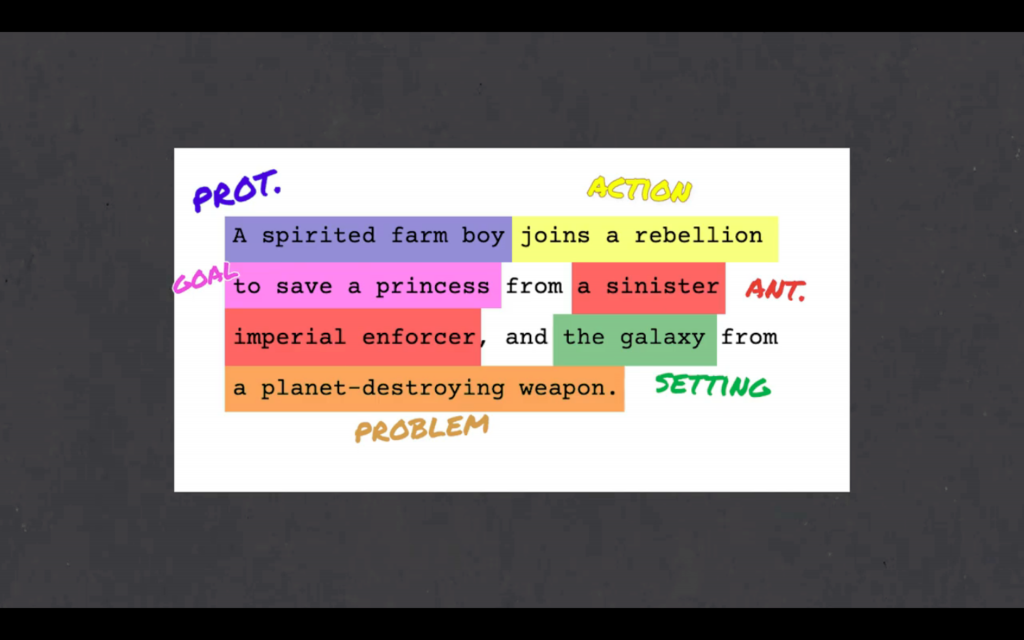A logline refers to an extremely short summary of a film or a book. It can consist of 30 to 50 words and will function as a short synopsis to draw potential viewers or production deals. The logline will also be the foundation upon which the script will reside. In fact, it is a good standard practice to create a logline before writing the script or screenplay. The video below will help to give you a clear explanation of what loglines are.
Popular Hollywood movies can rely heavily on these condensed plots to achieve the success that they now have. A popular example would be:
“With a single word, Tenet, and fighting for the survival of the entire world, a Protagonist travels through a world of international espionage on a mission that will unfold in something beyond real time.”
The above example is from the recent Christopher Nolan blockbuster film, Tenet. This single sentence consisting of around 35 words denotes the basic story of the movie.
Concluding points that demand consideration:
- A logline is a condensed form of a movie plot consisting of a single sentence of 50 words.
- It has to be compelling enough to promote the movie or script.
- It should be present at the beginning of the script.
Importance of a Logline
Before getting into the intricacies of a logline and how to write it, it is essential to understand its purpose. A logline can be useful to not only the one writing a script but also to other parties as well. A logline is of importance to the following individuals:
Script Writer
Writing a full script can involve intensive planning before even being able to write the first actual line of dialogue. Therefore, you will not only have to create a cohesive plot but also remember each plotline to prevent the appearance of plot holes.
Loglines can greatly benefit the scriptwriting process as it helps a writer to remember the main characters and their motivations. It can also help to direct the story on the desired path during the writing stage.
Producer
The producers may sometimes need to read through several scripts a day. Mind you; most scripts are aimed towards creating feature-length films. Therefore, the producers cannot read through the entirety of every entry they receive.
For this reason, a producer will first read the logline of the script before the actual script itself. This will ensure if the entry is worth their time. In a sense, a logline can act as a device to pitch a movie idea to possible investors and producers.
Audience
Most streaming platforms display an array of movies along with the logline. This is partially due to the fact that the public prefers to determine the value of the movie quickly and efficiently before watching it or moving on to a new one. Therefore, the logline, which will function as a synopsis, in this case, will help them do just that.
Chance Meetings
In the film industry, loglines possess a sense of such importance that it even has its own nickname. Both producers and writers use the term “Elevator Pitches”. The reason behind the name is that one can use a logline to provide a quick rundown or pitch in the time that it takes for one to use an elevator.
It can explain what you are working on without sounding like you have no idea in a less professional setting with friends or family.
Points that emphasize the importance of a good logline:
- Assists the writer as they write the screenplay or script.
- Helps producers and investors to better understand the project in a short time.
- Increases the number of views or ticket sales as audiences want to watch the film
The Ideal Logline
There is really no standard method of writing a logline. But there is a structure that most loglines follow. The ideal log line will work to hook an audience or a producer with the story that is at hand. The aim is to use a few lines to arouse feelings of curiosity in the soon-to-be viewer or producer. Let us dive into the different components that should be present in a logline.
- The good guy:This will be the character that occupies most of the story and who is created to be liked by the audience.
- Villains or antagonists: This character will function as the reason for the conflict or the protagonist’s woes.
- Setting or time period:This can be an indication of the era or year the film will take place in. It can also refer to the location that the film takes place in.
- Conflict or problem: The obstacle that hinders the main character from achieving his or her goal can also contribute to making a logline compelling.
- Action:This refers to the plan that the character sets in motion in order to overcome the aforementioned problem.
- Endgame or aim:The goal of the protagonist should also be alluded to. This will help the audience to understand the purpose of the movie.

The above picture is a screengrab from this video. It will serve as an example that will help to clear any confusion in this section and the sections to come. Notice that it possesses all the parts that were mentioned above. As a side note, the logline present in the picture is from the Stars Wars Franchise. (Star Wars: A New Hope, to be precise)
As per this article, the above components will relate to each other in the following manner:
Protagonist → Antagonist→ Conflict→Protagonist’s Goal
However, this order can undergo some shuffling depending on the writer and the tone of the script that one is going for.
Points to remember before writing a logline:
-
- Determine the protagonists, antagonists, and other components of the project.
- The ideal log line will capture the curiosity of the viewers without reading a full synopsis.
- The components of a logline can be written in any order as per the whims of the writer.
Steps To Writing a Compelling Logline
When you are a screenwriter, it can be challenging to condense an entire feature-length script into 50 words or fewer. However, it is not impossible. According to the experts who have been in the field for years, a logline can act as a synopsis. But it should not be a synopsis. To better understand this statement, it is essential to delve into the process of writing a logline. To do so, we will be examining each of the above components:
Protagonist
Of all the characters in the movie, the usual case is that viewers will spend the most time with the protagonist. In other words, the majority of the movie or the script will be devoted to the “good character.” Therefore, viewers will focus on this character and their motivations.
For this reason, it is crucial to describe the character as clearly as possible. To understand how to write compelling characters, visit this article.
The information cannot be excessive because there are five other items to be mentioned in 50 words and one sense. So follow the tips given below when writing the character:
-
-
- Adjectives
-
Describing words is your friend in this case. The use of adjectives will help to create a short sentence. In addition to this, the writer is also capable of accurately describing what the character is and does.
For example, in the above picture, the protagonist is said to be “spirited”. This is a noble character feature that is sure to resound with the audience.
-
-
- No Name-Calling
-
Names are of little importance in log lines. This is because it does not serve any tangible purpose in the events that take place in the movie. Therefore, refrain from providing names that will ultimately take up those precious 50 words. In the example, there are three subjects, and none of their names are present.
-
-
- Occupations
-
Instead of the names, it can help to add the occupation of the protagonist. This helps to give a bit of background or insight into the character. This is because occupations play a major role in the personality of the character. It can also contribute to the other components like the character’s actions and goal. In the above case, the character is a farm boy denoting that he does not have many resources in the first place.
Antagonist
Since the antagonist is a character as well, the above points are also applicable here. In this case, the character traits of the antagonist must denote strength. This is because it helps to raise the stakes of the story as the protagonist tries to defeat them. The example states that the antagonist is a sinister individual.
He is not given a name, but the viewer uncovers that he is an “imperial enforcer,” which helps to establish his strength. Thus, the farm boy, aka protagonist, has to face a scary and demanding challenge.
Setting
The setting helps the audience to further understand the situation the protagonist is in. For example, a movie follows a French mother looking to deliver a child in the 1500s. It is a fact that scientific advancement in France at that time had not seen a lot of advancement.
Therefore, there is a high chance the delivery will go awry. This probability helps to add more stakes that compel the viewer to watch the movie. In the case of the Star Wars example, a simple farm boy has to venture into the galaxy (the setting). This will all be new to him, considering he has never been in outer space.
Conflict or Obstacle:
This will help elevate the stakes in the story. In fact, it is the primary and direct source of odds that will encourage the viewer to watch the movie. The conflict in the example is the “planet destroying weapon.” The fact that the bad guy has such a powerful weapon invokes a sense of urgency in the viewer. It denotes that the odds are indeed stacked against the farm boy.
Pro-tip: Plot devices like Time bombs in Inglorious and other classics should also receive an honorable mention. This will help to intrigue the viewer even more.
Action
The action that is mentioned in the logline should accomplish two things. Firstly, the action has to be drastic if the antagonist or the conflict is drastic. It cannot be such that the farm boy goes after a weapon yielding antagonist in outer space by himself with a shovel.
Since there is strength in numbers, he will join a rebellion. The second thing it should accomplish is the basic plan that the protagonist will carry out to overthrow the antagonist.
Aim
The aim will be the final and most important aspect of the logline. It is the component that will contribute the most to the line and also add to the character trait of the protagonist. The goal of the farm boy to save the princess will paint the protagonist in a positive light. It will also align with his “spirited” nature.
Therefore, one has to keep in mind the following points:
-
-
- Adjectives to describe the character without using too many words. Thus ensuring lots of information in a short sentence.
- Ensure that each component adds stakes to the story to compel viewers to watch the film.
- Mention time constraints like time bombs or death.
- Ensure the setting is well established.
- The goal of the protagonist should be clear and align with their character.
-
Difference Between a Logline and a Tagline
Now that you know exactly what a logline is and its implications, it is important to establish what is not. Many beginners tend to confuse a logline with a tagline. This is a major blunder that could cost the writer and the story dearly. A typical log line differs from a tagline in the following ways:
-
-
- A logline is a short summary of the movie plot. A tagline is a sentence that finds use in promoting the film.
- Loglines usually present at the beginning of a movie script. It is also found on streaming sites. Taglines are present on the movie poster that plays a major role in the marketing of the film.
-
Let us consider the loglines and taglines from the first movie in the Now You See Me Franchise. The logline is: The film follows an FBI agent and an Interpol detective who track and attempt to capture a team of magicians who pull off bank heists and robberies during their performances and reward their audiences with the money.”
However, the tagline is “The closer you look, the less you will see.” Therefore, the tagline cannot relay any information regarding any characters or their motivations. It is a riveting statement that catches one’s attention but does not offer more information.
How Does a Slugline Differ From a Logline?
Slug Lines and loglines are two completely separate terms that have no relation to each other. However, the only relation that they possess is that they are both present in a screenplay.
A slug line is a term that refers to the lines in a screenplay. These will denote a change in scenery or a scene in general. For example, a telephone conversation occurring between two or more characters can involve two or more characters. The camera will shift from person to person. However, in recent times, this term has not seen much usage.
You can learn more about this term in the article here.
In short, a Slug Line acts like a subheading in a script. Loglines function as a short premise of a film.
Is a Logline Similar to a Synopsis?
Another common misconception in the scriptwriting world is that a logline is a synopsis. This cannot be further from the truth. A synopsis possesses the following differentiating features:
-
-
- A synopsis involves a description of the story and its characters in more detail.
- It can range from two to five lines or more.
- A writer uses the synopsis to add more information about the characters and their backstories. This could help to flesh out the characters a bit more.
-
Side Note: A treatment is a synopsis that goes on for longer than a page. In other words, it is a summary that may reveal important plot points in more detail.
How to Frame a Logline for Dual Story Scripts
Now that the definitions and working process is out of the way let us move on to special cases. Loglines for films with a single plot involving a set group of characters can be written relatively easily after keeping in mind the above points.
However, a problem appears when the story involves different settings and different characters. This is essentially what a Dual Story is. When the film follows the lives or conflicts of two separate characters in two different worlds, we get a dual story.
So, how does one condense two stories in one sentence? Usually, dual stories involve one connecting link between the two worlds or the characters present in the two worlds. While writing the logline, it is imperative to profit off of this connection.
For example, the logline of Julie and Julia is as follows, “The story of a young woman determined to cook her way through Julia Child’s famous cookbook, alongside the adventures of Julia Child’s life.”
Therefore, the audience realizes that two stories will occur simultaneously.
Creating Loglines for Different Genres
One of the major requirements involving the writing of loglines is that they should denote the genre of the movie. Let us take the stars wars logline into consideration (yet again). The fact that it involves a galaxy denotes that it is a Sci-Fi movie. Therefore, the individuals that enjoy science fiction movies will gravitate towards them. Learn more about movie genres here.
Therefore, the following components will help to establish the genre of the movie:
-
-
- Occupations or characteristics of the characters. The priest is an exorcist in the Exorcist. This denotes that it is a horror movie.
- Setting or location of the story
- Conflicts that the characters have to face. For example, the love story between Jack and Rose in Titanic involves the conflict of a sinking ship.
-
Therefore, each component of a logline can be utilized to tell the audience what kind of genre they will be watching.
The Ultimate Rule List for Logline Creation
What better way to end this article than to throw a list of rules at you? Although you can always deviate from the rules above, try to adhere to the rules below:
-
-
- A logline has to be concise, consisting of 30-50 words at the most.
- Use shocking or interesting adjectives to draw the reader.
- Make the goal of the character as clear as you can.
- Refrain from using clichés or any plot lines that may bore the audience. Try to stand out.
- Stay away from questions in the logline.
- Refrain from giving away too much of the plot or the twist ending (if present).
- Do not be too obvious with the logline.
- Ensure that each component is properly established and clear.
-
There are several right ways to write a logline, and you can learn these when you take up a filmmaking course. On the other hand, there are many wrong ways as well. Writing loglines can take time even though it possesses less than 50 words. However, that should not deter you from writing and re-writing it as many times as you feel is required. Remember, the goal is to give your story and script an advantage over every other script with just 50 words or one sentence.














